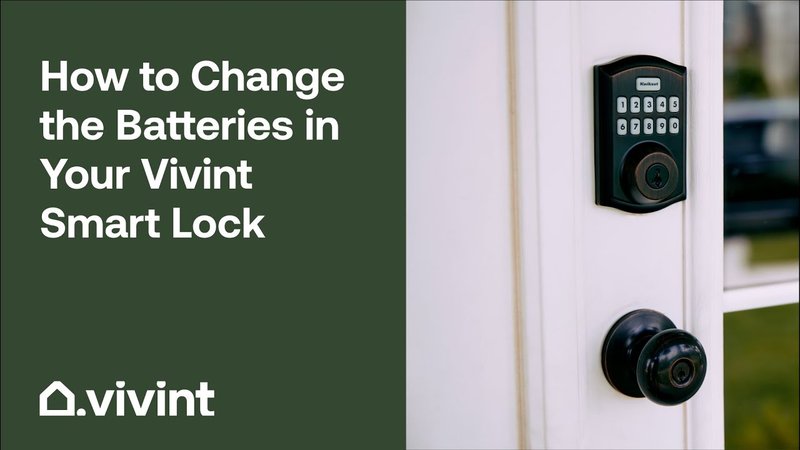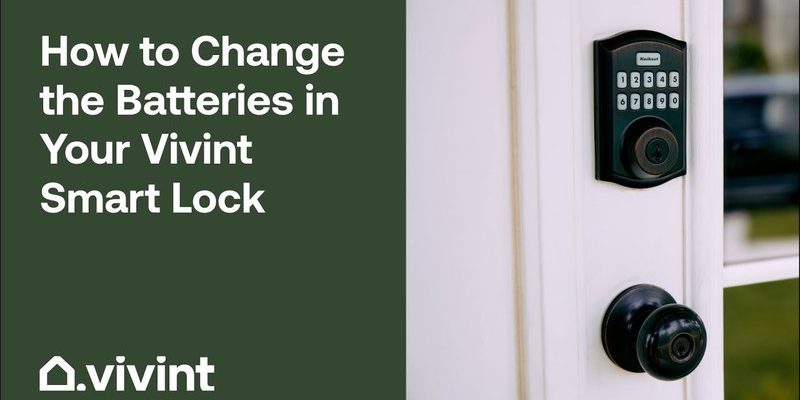
Here’s the thing—replacing the battery in a Vivint Smart Remote isn’t rocket science. Still, if you’ve never cracked open a gadget before, the whole idea can feel a bit intimidating. People sometimes picture tiny screws, confusing codes, or some hidden “gotcha” that makes things trickier than expected. Honestly, though, once you know what to look for, it’s a five-minute fix—no tech degree required. Let’s walk through it step-by-step, because nobody wants a dead remote when they need it most.
What Is a Vivint Smart Remote, and How Does It Work?
A Vivint Smart Remote is a handy little device that lets you control your Vivint home security system from anywhere in your house. If you think of your security system as the “brain,” this remote is like the magic wand for everyday use—arming, disarming, triggering panic alarms, or syncing with other devices on your Vivint hub. For many folks, it’s far more convenient to have a physical remote than to dig out a phone or use a wall panel every single time.
The remote communicates wirelessly with your Vivint panel using encrypted signals. This keeps your system secure but also means the remote needs a reliable power source. When the battery drops low, you’ll notice the remote gets sluggish—maybe you have to press buttons twice, or they don’t respond at all. Waiting too long can even mean re-pairing or resetting, which can definitely feel like more hassle than it’s worth.
What trips up a lot of users is recognizing how *essential* that little battery is. It’s not just about convenience—if your remote is out of juice, you’re losing a layer of security and peace of mind. So, keeping the battery fresh really does matter for the whole system.
Signs Your Vivint Smart Remote Battery Needs Replacement
A dead remote isn’t always as obvious as it sounds. There are some sneaky signs your Vivint Smart Remote battery is on its last legs. Some folks notice:
- Button presses don’t trigger the security system.
- The indicator light on the remote becomes dim, flickers, or doesn’t light at all.
- You have to press buttons much harder than before to get a reaction.
- Random disconnects or the need to re-sync or reset the remote more often than usual.
You might be wondering: why not just leave it until it dies completely? Well, some Vivint remotes can lose their pairing code if the battery drains all the way, meaning you’ll have to go through the pairing process from scratch. That’s not the end of the world, but it’s a hassle you can usually avoid by keeping the battery topped up.
Personally, I think of it like changing the batteries in your smoke alarm. You could wait until it starts to beep, but isn’t it nicer to get ahead of the problem? If you spot any of these warning signs, it’s time to break out your screwdriver (don’t worry—it’s easy).
Choosing the Correct Replacement Battery
Here’s where people sometimes get tripped up: not all batteries are created equal. Vivint Smart Remotes most commonly use a CR2032 coin-cell battery (sometimes called watch batteries). It’s important to double-check the back of your remote or your user manual to confirm this—using the wrong type, or a low-quality battery, can cause issues with syncing, pairing, or even damage the contacts inside the device.
If you’re standing in the store staring at a wall of batteries, you’ll want to remember that brand matters less than freshness. Coin batteries have a shelf life, so check the “use by” date on the packaging before you buy. Knockoff batteries might be cheap, but they tend to die quicker and can even leak—yikes.
Pro tip: If you see any crusty white residue when you open the remote, that means the old battery leaked. Clean it up before popping in a new one, or you risk corrosion messing up those delicate contacts.
Stock up on a couple of spare CR2032s, and you’ll never get caught empty-handed.
How To Open the Vivint Smart Remote Safely
Opening up a Vivint Smart Remote is surprisingly straightforward, but you’ll want to go slow. The last thing you want is to crack the plastic or damage the internal circuit board by muscling it open like a candy bar wrapper.
Most Vivint remotes have a small screw holding the battery cover in place. Grab a small Phillips screwdriver—think eyeglass repair kit or a mini precision tool. If your remote doesn’t have a visible screw, look for a notch or groove along the seam. That’s where you can slide a fingernail or a thin plastic pry tool (never use a metal knife, which could scratch or short something inside).
Once the screw is out, gently lift the back cover. If it feels stuck, double-check for a hidden latch or a second screw before forcing it. A gentle wiggle usually does the trick. You’ll see the coin cell battery nestled right in the center, often held by a simple metal clip.
Take a photo of the battery’s orientation before you remove it—honestly, it’s easy to forget which way the positive (+) side was facing.
Step-by-Step: Replacing the Battery in Vivint Smart Remote
Let’s break this down into bite-sized steps. If you get stuck, just back up and double-check—there’s no rush.
- Open the remote case as described above.
- Remove the old battery. Use your fingernail or a non-metal prying tool to pop out the old CR2032 cell. Note how it was positioned (take that handy photo).
- Insert the new battery. Slide the fresh CR2032 into the slot, matching the positive side to the markings in the compartment. Usually, the positive (+) faces up, but it’s always worth confirming.
- Check the contacts. Make sure the metal clip makes solid contact with the new battery. If it’s bent or dirty, gently bend it back with a toothpick or soft tool—don’t use anything sharp.
- Snap the cover back on. Replace the screw if there was one, or snap the case until it clicks.
Honestly, you’ll probably spend more time looking for your screwdriver than actually swapping the battery.
Testing and Syncing Your Remote After Battery Replacement
After changing the battery, it’s smart to give your Vivint Smart Remote a quick test. Press one of the main buttons and check for the LED flash or indicator light. If it lights up solid and your security system reacts, you’re golden.
Sometimes, the remote might lose its sync with your Vivint panel. Don’t panic—this just means you’ll need to pair it again. Here’s the usual process:
- On your Vivint control panel, go to the menu and select the option to add or pair a remote.
- Follow the on-screen instructions, which usually involve pressing and holding specific buttons on your remote.
- Wait for the panel to confirm a successful connection. If it doesn’t work the first time, remove and reinser the battery to reset the remote before trying again.
If your remote still doesn’t power on, double-check that the new battery is fresh and properly seated. Occasionally, dirty contacts or a faulty battery can cause issues—even right out of the package.
Troubleshooting Common Vivint Smart Remote Battery Issues
Even after swapping the battery, there are a few hiccups that can pop up. Many users run into these snags:
- Remote isn’t responding at all. Double-check the orientation of the battery. If it’s backward, it won’t work—yes, it happens to all of us.
- LED flashes, but the system doesn’t respond. This usually means the remote needs to be re-paired. Go through the sync steps mentioned above.
- Battery drains quickly. Some generic or expired CR2032 batteries don’t hold a charge. Try a higher-quality battery, or check if the battery compartment is clean and contacts are making a snug connection.
- Intermittent performance. If the remote only works sometimes, you might have corrosion or loose contacts. Clean the compartment gently with a soft cloth or a bit of isopropyl alcohol—just be careful not to damage anything.
Still stuck? Sometimes remotes can be defective. If you’ve tried everything and it just won’t hold a sync or reset, it’s worth reaching out to Vivint support for a replacement.
Comparing Vivint Smart Remote With Universal Remotes
You might be curious: what’s so special about the Vivint branded remote? Couldn’t you just grab a universal remote and skip the fuss? Here’s the reality: security system remotes aren’t like TV remotes. Vivint’s remote is designed to use encrypted communication with your specific panel, and it often requires proprietary coding to sync or pair.
A universal remote typically won’t work with a Vivint security panel, because the coding, battery requirements, and pairing protocols are different. If you try to use a universal remote, it won’t be able to arm, disarm, or trigger any specific Vivint commands. Plus, Vivint’s remotes often include extra features, like panic buttons or emergency alerts, that won’t be present on a third-party remote.
If your Vivint remote stops working even after battery replacement, the best move is to contact Vivint to get a replacement or troubleshoot your existing device.
Why Regular Battery Maintenance Matters
It’s tempting to think of remote batteries as a set-it-and-forget-it thing. But when it comes to home security, a dead remote isn’t just inconvenient—it can be a genuine weak point. If you can’t arm or disarm your system quickly during an emergency, you don’t get the peace of mind you paid for.
I like to swap out my Vivint remote battery once a year, even if it’s still going strong. It’s like changing your phone case: a little effort now can save a lot of hassle later. Plus, if your panel ever needs to be reset, you’ll know your remote is ready to re-sync right away.
Think of battery maintenance as “cheap insurance” for your home’s safety. A few dollars once a year beats scrambling during a real emergency.
Wrapping Up: Keeping Your Vivint Smart Remote Reliable
A Vivint Smart Remote isn’t just a gadget—it’s a core part of your home security flow. Replacing its battery might seem minor, but it plays a huge role in how smoothly your whole system works. With the steps above, you’re ready to swap batteries like a pro—no tech headaches, no wasted time.
Keep a couple of fresh CR2032s on hand, check your remote for those subtle “battery low” signals, and tackle swaps the minute things feel a bit off. That way, when it matters most, your Vivint Smart Remote won’t let you down.
